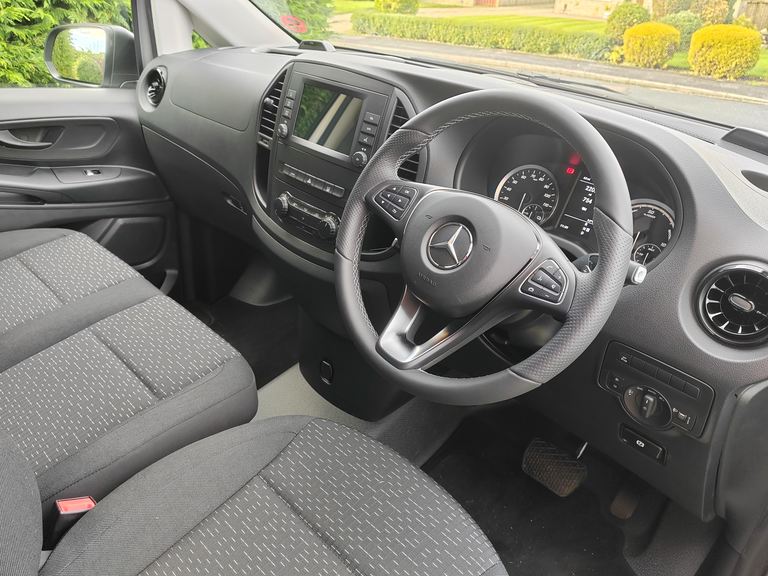Electric Vans / Electric Van Reviews / Mercedes-Benz eCitan
The Vito has been around for quite some time now and has never quite achieved the success in the UK that it has in other European markets, competitors such as the Vauxhall Vivaro, Ford Transit Custom and Volkswagen Transporter consistently doing better in the medium van sector. But with a new, revised drivetrain, can the electric eVito (watch our video review) succeed where the diesel van has faltered? Van Expert Tim Cattlin has just spent a week with one…
The medium van segment is probably the most hotly contested of them all – the market for these vans is huge and competition between manufacturers is fierce. No more so with the advent of the electric van, with some excellent products out there and others in the pipeline. The eVito got off to a shaky start, a small battery meaning that the van had an official range of under 100 miles, and in reality, a lot less than that. Mercedes-Benz saw the error of its ways and has relaunched the van as a more competitive and practical proposition.



The eVito, available in L2 and L3 lengths is a good looking van, especially with metallic paint, chrome grille and the alloy wheels that appear on the higher ‘Premium’ trim level. Some might say it looks more like a van version of a people carrier / shuttle bus (more on this later) but, the lines look great and it’s arguably a contender for the smartest looking van of any size. That’s subjective though, and if I’m perfectly honest, I don’t totally agree.
The standard door configuration is twin rear doors (a tailgate being an option) and twin side loading doors. The loadspace floor is covered in plastic, there’s a steel bulkhead and six tie-down points are there to secure your load. The all-important load length measurements are 2831mm in the L2, the L3 providing 3061mm but, in a sneaky move the manufacturer has included 370mm of space under the front seats in that dimension. Load volumes are 6.0 and 6.6 cubic metres respectively.
On to the statistic that can cause electric van manufacturers a bit of a headache, the eVito’s payload. And… it’s not too shabby at all, the van having the capacity of between 824kg and 882kg depending on the model which isn’t a million miles away from its diesel sibling. One aspect that is less than impressive, you can’t tow with this van. Most of the eVito’s competitors have now overcome this hurdle, but there’s no doubt that this could lose Mercedes-Benz a few orders.
This new version of the eVito has a 66kWh battery pack providing an official WLTP Combined cycle range of 162 miles, putting to shame the previous combination of 41kWh and 96 miles. I’ll always pop the reminder in that these figures should be used for comparison purposes only; your real world range is likely to be significantly less. The motor has an output of 114hp which is one of the lowest of any electric van currently on the market meaning that the van could struggle a little when fully laden, especially on motorway gradients.
Charge time from your 7kW home wallbox? Reckon on around 8 hours and a DC public chargepoint will get you from 0-80% in around 35 minutes providing you find one offering a decent charge rate.
If I’m brutally honest, the cab interior looks a little dated. The centre section boasts the imposing, flat and tall section favoured by Mercedes-Benz in its vans and it gives a slightly claustrophobic feel, particularly to a passenger in the centre seat. The multimedia unit is small by today’s standards at just 7”, although it is perfectly useable and may well be preferred by some drivers who may be a little overawed and distracted by the 10” or 12” offerings found elsewhere. The instrument panel is clear and customised to show the specific information an electric van user needs such as power usage, the amount of recuperation being achieved and the remaining battery capacity and range.
Pop your big, chunky Mercedes-Benz plug (it’s not really a key) into the slot, turn it fully and you’ll be ready to engage Drive by moving a stalk on the right side of the steering column. Personally, I think that the correct place for a drive selector is where the gear lever would otherwise be situated but, that’s just me and many no doubt will have the opposite opinion.
Next, to the elephant in the room. Has Mercedes-Benz finally got rid of the horrible, foot operated parking brake, which you release by pulling a handle with a loud ‘clunk’ to accompany the operation? No. No, it’s still there and personally I dislike it with a passion. You do get used to it but it seems archaic, especially as many vans now have an electric handbrake which requires hardly any driver intervention.
The van moves quietly and steadily away, without drama and although it’s not going to win any traffic light Grand Prix, it’s performance around town is adequate. Out on the open road it’s a different matter and overtaking has to be judged carefully. Most electric vans excel at this but with the low powered motor the eVito needs to be driven cautiously until the driver gets familiar with what the van can, and cannot do.
The eVito has a number of recuperation modes. Select the highest level and you’ll rarely need to use the brakes; the effect being so pronounced that the vans stop lights illuminate when the van is coasting. This adds useful range to the battery pack, but most drivers will probably select a less brutal mode which will give a smoother driving experience.
Generally, the van drives well with the caveats previously mentioned. Build quality is good as you would expect but the almost brand new test van had an odd squeak and rattle which was a little disappointing. Noise levels in the cab are low, although road noise seemed a little intrusive at times. The remaining range indicator was very accurate, something other manufacturers could take heed of, a 40 mile drive in cold weather saw the range gauge drop by 39 miles. Having said that, I lost 20 miles before turning a wheel after using the heater to demist the windscreen. Not preconditioning any electric van whilst still on charge will have a similar effect.
It looks good, it drives OK, the load carrying capability is more or less competitive and it comes with a decent spec. But somehow, it falls a little short. It’s good at many things but doesn’t excel at any of them and to me, it has always felt like an MPV that has morphed into a van.
It’s OK, it’ll do the job, but others do it better.